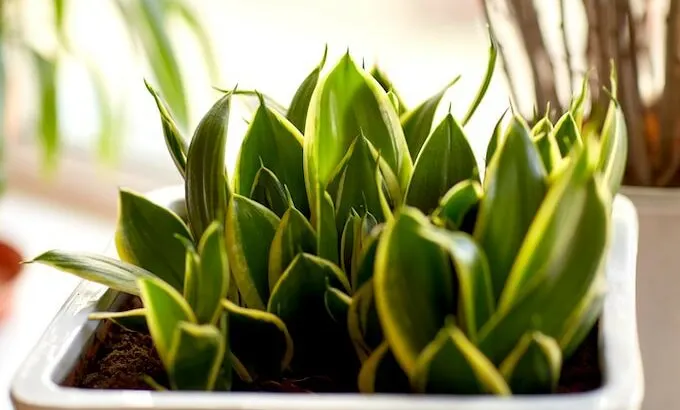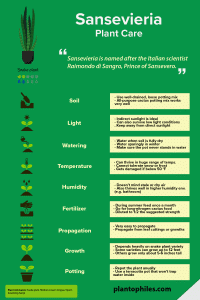Sansevieria grows erect with sword-shaped leaves.
It is a member of the Agave family (Agavaceae) according to the University of Florida and consists of about 60 species.
The University of Maine adds that Sansevieria is also known as Mother-In-Laws Tongue or just Snake plant.
Also known as the snake plant, it’s a low-maintenance plant that can survive in a huge range of temperatures, low light conditions, or even little water!
Here’s a complete guide that takes you through the right way of Sansevieria care and the conditions that work best for a healthy plant.
Sansevieria Care
To care for Sansevieria provide well-draining potting soil such as a cactus mix and bright indirect light. Water once a month and provide a temperature of 60-85 °F (16-29°C) and a humidity between 40-50%. Fertilize monthly using a liquid fertilizer at 1/2 strength.

Sansevieria Care
Table of Contents
Sansevieria Care Guide
Sansevieria can survive almost all lighting conditions and air qualities.
They are calling for minimal care in terms of watering and feeding with fertilizers.
Take a look at a Sansevieria care guide that I created.
If you are following these tips you are keeping your Sansevieria healthy and beautiful.
Spoiler alert: Sansevieria thrive in neglect
Soil
Sansevieria prefer a well-drained, loose potting mix.
Choose a potting soil that’s low in peat, eventually packing and refusing to drain or re-hydrate properly.
The most recommended option is an all-purpose cactus potting mix.
Every time your snake plant grows 2-3 inches taller, make sure you add a half-inch of potting soil to the pot to provide adequate support to the leaves.
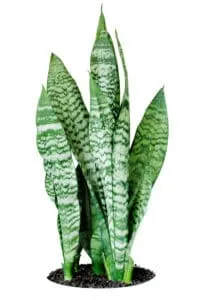
Sansevieria need well-draining potting soil
Light
Sansevieria grow best in bright indirect light.
The best location to place a Sansevieria is in front of a sunny window-lined by a sheer curtain or a north-facing window.
Although, Sansevieria grows just right in low light as well, going for bright lighting brings out vibrant colors in the leaves.
Make sure you never place the plant in intense natural light as it will make the leaves burn and turn their edges yellow.
Keep the plant out of the direct sun.
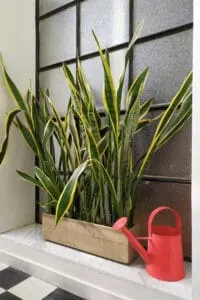
Sansevieria grow best in bright indirect light
Watering
Water Sansevieria once every 4 weeks.
Before you water a Sansevieria plant, allow the soil to get fully dry, further watering properly until the water starts dripping through the drainage hole.
Once the pot drains, discard the remaining water that lands up in the saucer.
Make sure the pot never stands in water and the soil never gets soggy.
It’s a must to water the plant sparingly during the winter season.
Sansevieria stores water in the leaves, and that’s why it can rot very quickly if it stays in excessively wet soil.
Temperature
Sansevieria grows best in temperatures between 60-85 °F (16-29°C).
Sansevierias is capable of thriving in a huge range of temperatures around the house.
In fact, they can stay healthy during hot summers as well as cold winters.
But a point to remember is that snake plants can’t tolerate snow or frost and get damaged below 50 degrees Fahrenheit of temperature (10 degrees Celsius).
So, make sure you bring them indoors before the weather gets too cold during winters.
Humidity
Sansevieria prefers a humidity between 40-50%.
Sansevieria doesn’t mind stale or dry air around the space, while also doing perfectly fine in bathrooms where they experience higher humidity.
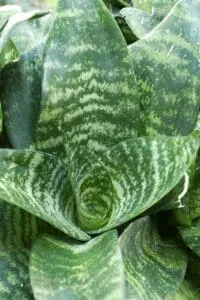
Sansevieria grow best in humidity between 40-50%
Fertilizer
Fertilize a Sansevieria once a month in summer and spring using a balanced liquid fertilizer at half-strength.
Throughout the spring and summer season, feed the snake plant once a month.
As it’s a houseplant, go for a low-nitrogen cactus food diluted to one-half the suggested strength mentioned on the container.
Avoid adding too much fertilizer as it will make the leaves of your Sansevieria fall over.
Propagation
Sansevieria can be propagated using leaf cuttings or by separating pups from the mother plant.
It’s almost effortless to grow new plants from leaf cuttings or the small new growths.
Place the tiny growths or leaf cuttings in potting soil, keeping them moist until the development of roots.
A period of 4-6 weeks is enough to develop roots.
Growth
Sanseveria grows up to 12 feet tall (3.7m).
The mature size of a Snake Plant varies according to the specific variety of Sansevieria.
Some varieties can grow really tall and reach up to 12 feet (3.7m)!
Others, like the popular Sansevieria Ttrifasciata Hahnii, grow only about 5-6 inches tall (13-15cm).
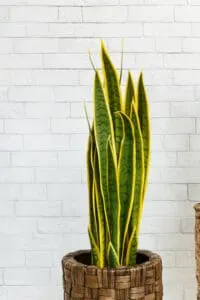
Sansevieria can grow up to 12 feet high (3.7m)
Potting
If the roots of the plant outgrow the planter, it’s time to repot Sanseveria into a larger pot filled with commercial potting soil.
Before repotting, you need to wipe the leaves with a damp cloth to remove the dust, further cutting any blemished or damaged leaves.
It’s best to go for repotting the plant annually, employing a terracotta clay pot for the same as clay pots are heavy and balance the plants with heavy tops without trouble.
Share this Image On Your Site or Download it here.
Watering Your Sanseveria Plant The Right Way
Although the snake plant is super easy to grow, it’s very essential to follow the right watering regime for a healthy Sansevieria.
Where to Water
Watering Sanseveria calls for some care. Make sure you only water the soil and not the leaves.
Water mustn’t be spilled on the leaves to prevent them from rotting.
A major rule to abide by during the growing season is to make sure that the top inch of the soil is dry before watering the snake plant again.
When to Water Sanseveria
It’s important to provide the plant with adequate water, while not going for overwatering as it may lead to the rotting of the roots.
During winters, only water your snake plant to stop the soil from drying out completely.
Plants don’t utilize as much water during winters as they do during the summer season, so watering them once a month depending on the degree of cold temperatures works best.
Going for too much watering in winter will make the snake plant rot.
Check whether the top inch of the soil in your snake plant is dry before you actually water it after the last watering session. Lastly, make sure the potting plant gets dry too.
The Right Water Quality
Prefer going for rainwater or distilled water for watering your snake plant.
If using tap water, let it stand for a minimum of 48 hours to let fluorides and chlorine dissipate.
To make sure the roots of the plant don’t get shocked, adjust the temperature of the water according to your room.
Water the soil, while making sure it makes its way through the drainage holes.
Sanseveria Propagation
It’s surprisingly easy to divide Sansevieria plants during repotting.
Also, new shoots that pop out from the soil can be used to pot independently.
Lastly, cutting leaves and planting them in new pots is always one of the most convenient options.
Below are the different methods of propagation.
Snake Plant Propagation in Water
You can also grow a new snake plant in a container of water.
Choose a jar or pot that’s tall enough to properly hold the leaf.
Go for a young and healthy leaf, further cutting it off using a clean and sharp shear.
Place the cut end in water in a way that it covers the bottom quarter of the leaf tissue.
Place the water container at a spot that gets indirect light, changing the water at regular intervals.
In a few days, you will witness tiny roots popping up.
Place the rooted plant in sand and take the aforesaid care steps.
Snake Plant Propagation from Rhizomes
Snake plant grows from thick organs called rhizomes that develop under the soil.
The rhizomes store the energy for optimum stem and leaf growth.
Pull the snake plant from its pot, further cutting its base apart into smaller sections using a hand saw or sharp shears.
Make sure to cut it in half unless the snake plant is very old and has loads of rhizomes.
At least three rhizomes, along with a healthy leaf work wonders per new plant.
Next, you plant the sections in fresh potting soil.
Propagation by Leaf Cutting
Propagating snake plant by leaf-cutting is the most widely used method to grow it, especially when going for indoor planting. Below are the steps that go into the process.
Step 1
You begin by selecting one or more healthy leaves from a full-grown snake plant, preferably going for leaves with fine color and thick flesh.
Step 2
Cut the selected leaf at the base with hand-held pruners or a pair of scissors. Cut the leaf at a 45-degree angle nearly an inch above the top of the soil.
Step 3
Place the leaf on a flat surface, further cutting it into a long section of 1-3 inches.
To make it easy to determine which end of the cutting points the top and which end points towards the roots, make appropriate markings.
It is essential to mark the leaf so it’s placed in the planter with its root side in the soil.
Step 4
Place the cuttings in a warm, dry place that has got good air circulation.
In about 5-7 days, the cut ends of the leaves will heal and callous over.
Check each end of the leaf cuttings for toughened areas and tiny white nodules that show root production.
Step 5
Put succulent potting soil in a one-gallon plastic pot.
You can also go for a blend of potting soil and pumice, coarse river in equal amounts.
Add 5 cups of water into the pot, letting it drain for 10 minutes.
Step 6
Place about 4-5 leaf cuttings into the pot, inserting one-third length of the cuttings into the soil.
Make sure you place the cuttings in a way that there’s a gap of an inch between each of them.
Step 7
Place the planter near a window that gets bright light and appropriate air circulation.
Make sure the spot gets indirect sunlight and above 70 degrees Fahrenheit of temperature.
Water the leaves once every week while making sure it wets only the top one inch of the soil.
Avoid overwatering snake plant cuttings at the time of rooting.
Step 8
Check for root production after 30 days by gently digging around the base of each cutting with your finger or the tip of a pencil.
Tugging on the cuttings to test for resistance is another way of checking for roots.
Step 9
Once the roots develop, repot the new-grown Sansevieria into separate 6-inch plastic planters filled with potting soil, going for the same moisture and lighting conditions as the mother snake plant.
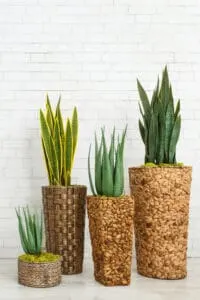
Variegted and original Sansevieria sansevieria trifasciata now know as Dracaena trifasciata
Signs that your Sansevieria is Unhappy
Calling for minimal care, snake plants are hard to kill, thereby being the ideal choice for most homeowners.
However, a few signs will let you know if your Sansevieria is unhappy.
Dull and Yellow Leaves
If the leaves of your plant look bright and green, the watering is going just perfect.
However, if the leaves look dull, the plant might be calling for more water while overwatering can also lead to yellow leaves.
So, it’s essential to monitor the leaves of the snake plant every once in a while.
Water-logged soil leads to rotten roots and a severe decline in the health of the plant.
Prevent the same by growing the plant in gritty, well-drained soil, while also watering it regularly if it’s in the growing season.
When growth slows down, water it occasionally and make sure the soil stays on the drier side.
Scarring of the Leaves
Exposure to unsuitable temperatures can lead to an ugly and unhealthy snake plant.
Leaving the plant outdoors in temperatures below 55 degrees Fahrenheit (13 degrees Celsius) will lead to scarring of the leaves, which is a permanent condition.
To avoid the same, keep the plant between 60-85 °F (16-29°C) of temperature, while the night time temperatures can range between 55-70 degrees Fahrenheit (13-21°C).
Mealybug Infestations
Spider mite and mealybug infestations are another common health problem that your snake plant may face.
The bugs will weaken the plant by sucking sap from it, further leading to tiny wounds on the leaves and leaf shedding.
Dabbing the mealybugs with alcohol or even handpicking them can control the problem, while you can wash off the spider mites and increase the humidity around the snake plant.
Insecticidal control can also work in certain situations.
In case, the plant seems heavily infested, you may need to discard it to avoid the nearby plants from getting infected.
Reddish Brown Leaves or Sunken Lesions
Red leaf spots and southern blight are a few fungal problems that can arise in a snake plant.
Taking a close look at the appearance of the plant will help you recognize such problems.
Leaves are the most-affected elements of the plant, displaying reddish-brown lesions, or at times, a web-like white-colored growth that hardens and turns dark brown over time.
It’s essential to avoid fungal problems as they can rot and kill your snake plant.
To avoid such problems, monitor the watering, keep the leaves dry, and maintain the right temperatures.

All Sansevieria such as the Sansevieria cylindrica should be repotted once the roots outgrow the container
Frequently Asked Questions About
Sansevieria
What are the benefits of Sansevieria plants?
Promotes The Flow of Oxygen: Snake Plant is one of the houseplants out there that produce the maximum amount of oxygen.
When there’s an increased flow of oxygen at your home or workspace, you will experience an improved mood and feel less stressed.
Reduces Carbon Dioxide During Nighttime: Snake Plants reduce the amount of carbon dioxide present in the atmosphere during the night.
It actually is capable of Crassulacean Acid Metabolism, which is the ability to perform a certain kind of photosynthesis in the dark.
That’s also the reason which makes it appropriate from dry climates and drought tolerant.
Prevents Air-Borne Allergies: Apart from reducing carbon dioxide and promoting oxygen, snake plant absorbs toxic volatile organic compounds present in the air, thereby minimizing the risk of airborne allergies.
Even if you use air purifiers or filters, placing this indoor plant can help air purification immensely.
Considered good in Feng Shui: Snake plant brings purifying and protective energy to the house if placed in a good position.
Its spiky leaves are considered to work wonders against negative Chi.
It’s recommended to place Sansevieria in fewer traffic areas, preferably, southern, southeastern, and eastern corners of the space.
Do all Sansevieria plants clean the air?
Sansevieria is one of the most efficient plants when it comes to cleaning the air.
Snake plant filters out nitrogen oxide, xylene, toluene, and formaldehyde during the nighttime.
That’s why a lot of people consider it to be a good luck plant as it cleans the air around you while you sleep.
The plant removes toxins through the action of its leaves and produces pure oxygen.
Unlike most other plants that produce carbon dioxide at night, the snake plant does the exact opposite by producing oxygen.
How often should I water Sansevieria?
The frequency of watering Sansevieria depends on the weather conditions, the temperature of the house, humidity, and lighting.
However, one can generally water their planet every 2-4 weeks.
It’s essential to water the plant sparingly, especially during summers times.
The frequency can go up to 4 times per week if your surroundings experience intense heat as it will make the plant use more water.
Is Sansevieria toxic to cats?
Sansevieria is moderately toxic to cats. In rare cases, the plant can lead to a dermatological reaction but proves to be toxic only if the animal ingests it.
Ingesting the plant can lead to excessive salivation, vomiting, nausea, and diarrhoea in cats and dogs.
In fact, even humans may suffer from short-term health issues including nausea, salivation, and mouth pain if they ingest the plant.
How do you care for a Sansevieria cylindrica plant?
Sansevieria cylindrica features lovely dark green leaves characterized by faint bands in light green.
It comes with cylindrical leaves instead of concave or flat ones, and that’s what makes the plant different from the other species.
It’s a low-maintenance, drought-tolerant houseplant that can thrive best even with very little water.
You can water them once or twice a month, or even less if the plant is placed indoors, and they will do just fine.
Conclusion About Sansevieria Care
I personally love Sansevieria care as Sansevieria is among the most forgiving plants I have ever seen.
What plant can you leave a month without watering and little sunlight and it still looks great?
For sure; I know you will care better for your Sansevieria but the resilience is exceptional!

Daniel has been a plant enthusiast for over 20 years. He owns hundreds of houseplants and prepares for the chili growing seasons yearly with great anticipation. His favorite plants are plant species in the Araceae family, such as Monstera, Philodendron, and Anthurium. He also loves gardening and is growing hot peppers, tomatoes, and many more vegetables.

